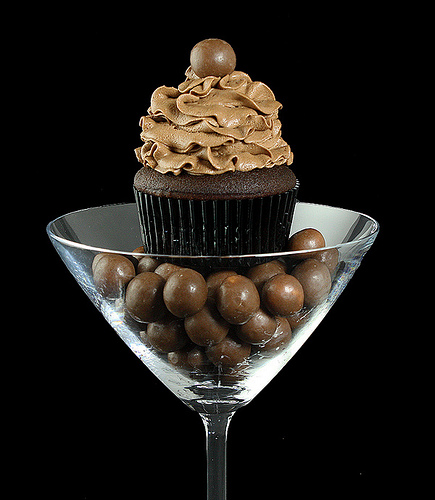
None for you. (Photo by Grace Langlois.)
When we think about eating unprocessed foods, it’s important to remember the parable of the unfortunate college freshman with the strict upbringing. The lad moved into the dorms and, finally free from the ironclad rules of his parents, proceeded to go buck-wild, boozing, philandering, and snorting his way to academic probation by midterms.
Lesson: We should all indulge once in a while — especially when it comes to eating. True, it’s much easier to strip out the processed stuff when you eat only home-cooked meals and never, ever have dessert. But to hold ourselves to such inflexibly high standards is only to invite a Keith Richards-style bender that ends with us twitching in a bathtub full of Mallomars.
That’s why, in my quest to eliminate processed foods, I cannot impose a blanket ban on indulgences like meals out and sweets. Luckily, I don’t have to. After a little trial and error, I’ve discovered that one can walk the unprocessed path and still enjoy a luxury item once in a while. My report from the trenches:
The challenge: Desserts
What’s wrong with a little dessert, you ask? Unless you’re the kind of highly evolved individual who can read a dessert menu full of tortes and bonbons and then actually order the fruit cup, we’re looking at added sugar. Probably refined sugar. Probably lots of refined sugar.
There’s a lot of debate swirling around out there about the sweet stuff — is sugar better than high fructose corn syrup? Is there such a thing as unprocessed sugar? Will sugar kill us all? — and I’m not dipping a toe into that snakepit. For my purposes, white table sugar counts as processed. Natural (or at least, minimally processed) sweeteners like turbinado sugar, maple syrup, honey, and agave nectar are okay because they pass the kitchen test — that is, you could do the processing yourself if you had the equipment and were so inclined.
Rather than trying to hocus-pocus up a whole-wheat Twinkie, I decided to test-drive two recipes with two different approaches to sweetening: One used raw agave nectar, and the other turned its back on added sugars altogether. Then I enlisted my boyfriend, Ted, and fellow sugar enthusiasts Laura and Matt to help me judge them.
I tackled the weirdest option first: chocolate “mousse” made with cacao powder, agave nectar, and avocado (recipes below). I was skeptical about this one to begin with, and the in-your-face blast of avocado flavor I got from a fresh-from-the-blender spoonful didn’t help. Still, I packed the mousse into four champagne flutes (it would at least look good, dammit) and put it in the fridge for a few hours’ chill.
Next up: peanut butter & banana “ice cream,” an alternative approach to the classic scoop that features frozen bananas and a splash of half and half in place of sugar, cream, and eggs. I tossed the fruit chunks into the blender with a hearty scoop of peanut butter, then, in a last-minute stroke of genius, added a dusting of cacao powder. Then I popped the blend into the freezer, congratulating myself on a sure crowd-pleaser without a granule of added sugar. (One might argue I had actually added sugar in the form of lactose, or milk sugar. But one would be getting awfully particular, wouldn’t one?)
A few hours later, I served the mousse first. (Always reserve something else in case of a mass tastebud revolt.) But to my surprise, it was a hit. “Yum!” Laura said appreciatively after her first bite. “This really tastes like a dessert,” Matt said. Surprised, I dug in. Say … the avocado had faded into the background of the creamy blend, hardly noticeable behind the new sweet, chocolaty notes. It took my tasters a few minutes to even guess the main ingredient. Well done, underdog.
The banana ice cream couldn’t match the mousse’s come-from-behind appeal. “This is really just a smoothie,” Laura said, pointing her spoon at me. “And it could use some of that agave nectar.” It wasn’t that the scoops tasted bad — just ho-hum, lacking pop. Only Ted picked it over the mousse, arguing, “I don’t like sweet desserts all that much.”
This much is clear: These alternative sugars can indeed carry a dessert. I can’t wait to experiment with more. And even you purists still have the fruit cup.
The challenge: Dining out
As with dinner parties, the issue with restaurant meals is that you didn’t make them yourself. You don’t know exactly what went into this sauce or that breading, and it can be difficult to get a straight answer out of a cagey server. But to my delight, eating unprocessed at restaurants was actually the easiest of my challenges. Just follow a few simple rules, and you’re in the clear:
- Choose wisely. Next time your buddies want to meet up for dinner, think more Gaia’s Vegan Garden of Flavor and less Applebee’s. You can hardly toss a stick in American cities without hitting an uberlocal, farm-to-table, we-grew-this-in-our-rooftop-garden restaurant these days, anyway.
- Go easy. When in doubt, go with the options that required the least effort from the kitchen. A salad made from a slew of whole, recognizable vegetables beats the hell out of a Bloomin’ Onion (and make it simple olive oil and vinegar dressing while you’re at it).
- Be picky. Hold this ingredient, substitute that one, and you’ll likely be able to create just the meal you’re looking for.
- Look for menu key words. Baked in-house, made fresh daily, and the names of any farms merit a second look.
- Beware the bread (it’s probably refined flour), sauces, and dressings. Ask what’s in them if you’re not sure.
- If it has a brand name in the title, don’t eat it. See: Oreo Madness®, Hershey’s Chocolate Dunkers®, Just a Big Pie Made of Oscar Meyer Classic Weiners, Kraft Singles & Snickers®.
Got it? Tuck in that bib and get out there.
Oh, it’s possible. Just the other night, I picked up a pizza from one of our favorite neighborhood joints — one we love for its squeaky-clean emphasis on local, seasonal, organic ingredients. (The cooks probably read to sick kids in the hospital in their spare time.) For dinner: a bubbling mess of mozzarella, mushrooms, zucchini, and peppers, all resting atop a whole-wheat crust and totally organic tomato sauce. I most definitely did not miss the preservatives.
Unprocessed Chocolate Mousse
(Source: My Healthy Eating Secrets) Serves 2-4
1/4 cup raw cacao powder (or unsweetened cocoa powder)
1/4 to 1/3 cup water
1/4 cup raw agave nectar
1 avocado
Peel the avocado and cut it into pieces. Place all ingredients in a blender and process until completely smooth. Spoon into serving containers and chill for two to three hours before serving.
Choco-Peanut Butter-Banana “Ice Cream”
(Source: 100 Days of Real Food) Serves 4
5 bananas
Splash of half and half or milk (less than ½ cup)
3 tablespoons peanut butter
Raw cacao powder to taste
Peel the bananas and break into pieces; place in the freezer for at least 4 hours. Add frozen banana, peanut butter, and cacao powder with a splash of half and half. Blend until smooth, adding half and half or milk gradually until you get the consistency of a smoothie. Put it in a bowl and freeze at least 2 hours before serving.



